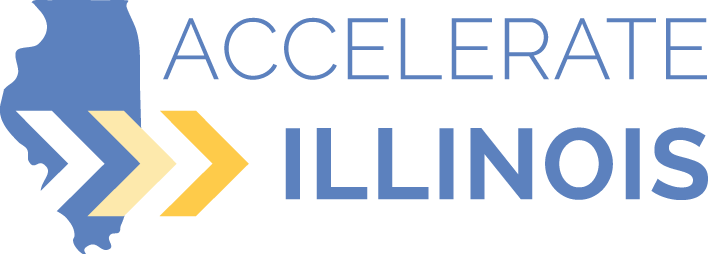Accelerate Illinois: With pothole season upon us, maintenance is cool again
Potholes are an easy target, but we all hate when our transportation infrastructure is run down and doesn’t work. There’s automobile traffic that costs the Chicago region $7.3 billion in wasted time and fuel, slow zones on the El (I can walk faster!), Metra switches that freeze in the cold (while we freeze on the platform texting our co-workers we’ll be late again) and Amtrak congestion going to Union Station (that last mile can take as long as the first 100). Why can’t we just get where we want to go on time?
All of these issues are a result of:
- As a nation we spend less and less on transportation infrastructure every year because tax revenues that power these investments have declined. The federal and Illinois motor fuel taxes that fund transportation have been fixed at 18.4 and 19 cents per gallon, respectively, since the early 1990s. Taking into account inflation and that your car gets much better gas mileage today than it did 25 years ago, gas taxes are no longer sufficient to maintain our current transportation assets, much less fund expansion. The federal Highway Trust Fund has required $50 billion in general fund bailouts over the past five years because revenues from the federal motor fuel taxes simply can’t keep up with the need.
- The U.S. transportation system was built 50 years ago and it’s falling apart, because, well, maintenance isn’t all that exciting so there’s no push to fund it. In the 1950’s when we built the national highway system, there were lots of ribbon cuttings to get excited about! Contrast that fervor with today, when Congress hasn't passed a "long-term" transportation authorization in a decade. The last one, SAFETEA-LU, had to be extended 10 times due to Congressional gridlock and the Highway Trust Fund will soon hit the bankruptcy deadline again.
- More of the budget goes toward increased spending on Medicare and Social Security payments every year as Baby Boomers age. According to the Congressional Budget Office, over the next decade, spending on Social Security and Medicare alone will grow by 60 percent, while spending on transportation—spending that fuels state and local government investments—is forecasted to only grow by 16 percent.
The latest Congressional Budget Office also data reveals the continuing trend in the decline of transportation spending as a share of U.S. Gross Domestic Product. It is down to just 1.36 percent, well below most European countries, Japan and China.

In 2014, $233 billion in federal, state and local dollars were invested in highways, mass transit and rail infrastructure. While that’s a large figure, since 2002, spending on transportation infrastructure at all levels has declined annually.

The solution: With fewer resources, the nation needs to:
1. Focus on maintenance first
Americans spend a long time commuting to work, more than every European country except Hungary and Romania. According to The Economist, “America's spending as a share of GDP has not come close to European levels for over 50 years,” and while “America still builds roads with enthusiasm…it spends considerably less than Europe on maintaining them. In 2006 America spent more than twice as much per person as Britain on new construction; but Britain spent 23% more per person maintaining its roads.” The result? No potholes!
As John Oliver hilariously and satirically points out, cutting ribbons for the next roads, bridges and trains hogs all the spotlight and, until last week (link to pothole video), I don’t recall ever seeing a ceremony for a pothole filling. But as I said, most of the infrastructure in the country is at the end of its useful life—that means roads with potholes, bridges that are uncrossable and trains that don’t run on time. With less and less money available for transportation, we need to focus investments on maintaining the infrastructure we have so it runs better before we build anything new and consider long-term maintenance costs when evaluating whether or not to invest in new capital.
Well, the latest Congressional Budget Office data also shows that maybe decision makers want fewer potholes too. While overall spending at every level of government is down, since 2002, there’s been a smart focus on maintenance over building new.

2. Update revenues: Illinois fuel tax revenues declining
In Illinois, the maintenance backlog is tens of billions of dollars, but per-capita fuel tax revenues have declined by more than a third since the early 1990s, even as construction costs have more than doubled because of inflation. Right now, the average person in Illinois is only contributing $8.25 a month through the state gas tax for the upkeep of our transportation network. I think it’s worth a few extra dollars a month to ensure we don’t get stuck with a more expensive flat tire because a pothole wasn’t filled.
Just in the past three years, 13 states have taken action to invest more in transportation and 18 more are considering action this year. If Illinois doesn't do something this year, not only will we continue to suffer potholed roads and delayed trains, but we will be less attractive to new businesses that want to invest and create jobs in Illinois.
The Metropolitan Planning Council’s Accelerate Illinois initiative, which is being conducted in association with AARP, Active Transportation Alliance, Transportation for Illinois Coalition, the Chicago Metropolitan Agency for Planning and others, is designed to address these issues that keep us from getting from A to B in a timely fashion by identifying new state funding for transportation.
Don’t be a victim to pothole season 2015—Join Accelerate Illinois today by adding your name to the growing list of Illinois residents and businesses letting our leaders in Springfield know that we are committed to improving our transportation systems.

